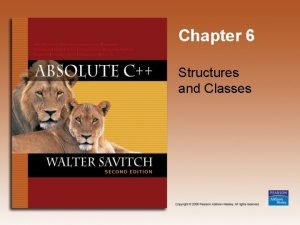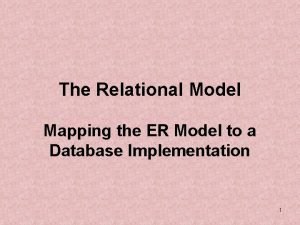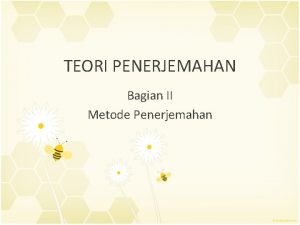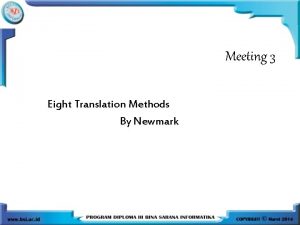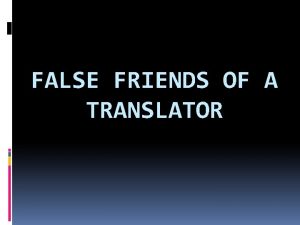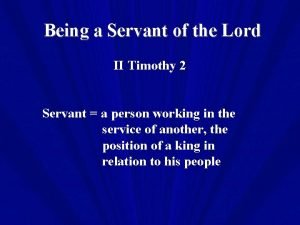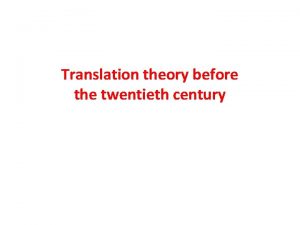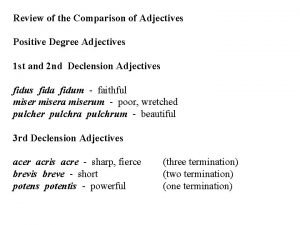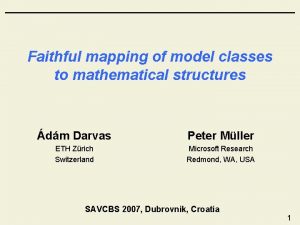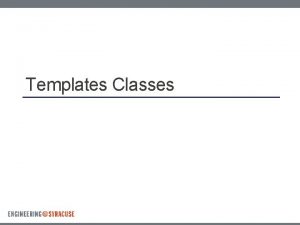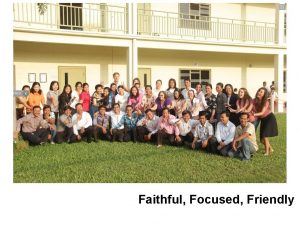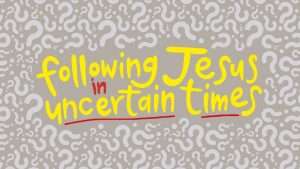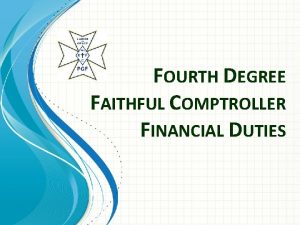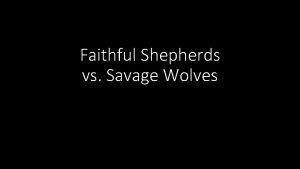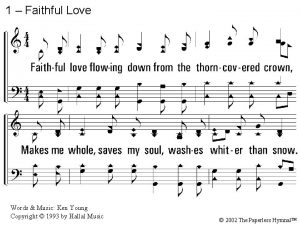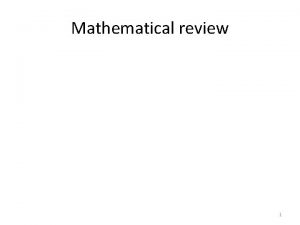Faithful mapping of model classes to mathematical structures






















- Slides: 22

Faithful mapping of model classes to mathematical structures Ádám Darvas Peter Müller ETH Zürich Switzerland Microsoft Research Redmond, WA, USA SAVCBS 2007, Dubrovnik, Croatia 1

Abstraction in OO specification languages § Abstraction is indispensable - to specify types with no implementation - to support subtyping and information hiding § Two-tiered specification languages (e. g. Larch) directly provide mathematical structures for abstraction § One-tiered specification languages (e. g. JML) provide model classes for abstraction 2

Model classes § Provide OO interface for mathematical concepts § Used as immutable types § Equipped with contracts (not shown) package org. jmlspecs. models; public final /*@ pure @*/ class JMLObject. Set { public JMLObject. Set(); public JMLObject. Set(Object e); public boolean has(Object elem); public boolean is. Empty(); public boolean is. Subset(JMLObject. Set s 2); public JMLObject. Set insert(Object elem); public JMLObject. Set remove(Object elem); … } 3

Use of model classes package java. util; //@ import org. jmlspecs. models. JMLObject. Set; public interface Set extends Collection { //@ public model instance JMLObject. Set _set; /*@ public normal_behavior @ ensures contains(o); @*/ public boolean add(Object o); /*@ public normal_behavior @ ensures result == _set. has(o); @*/ /*@ pure @*/ public boolean contains(Object o); … } 4

Handling of model classes – pure methods For verification, model classes need to be encoded in underlying theorem prover By encoding pure methods [Darvas. Müller 06, Jacobs. Piessen 06] - pure methods encoded as uninterpreted functions - functions axiomatized based on pure-method contracts Problems - theorem provers optimized for their own theories, rather than encodings of pure methods - difficult to ensure consistency of resulting axiom system 5

Handling of model classes – direct mappings For verification, model classes need to be encoded in underlying theorem prover By direct mappings [Leavens. EA 05, Charles 06, Leavens. EA 07] - map model classes directly to theories of provers - map pure methods to functions of selected theories - mapping based on signature Problems - mapping ignores contracts - possible mismatch between contract and semantic meaning of selected function - leads to unexpected results during verification and runtime assertion checking 6

Faithful mapping of model classes to structures § Our contribution is an approach that - follows idea of direct mappings takes contracts into account formally proves that mappings are semantically correct allows identification and checking of redundant specs § Approach - leads to better quality of model class specifications - eliminates semantic mismatches 7

Specifying and proving faithfulness of mappings Approach consists of 3 stages: 1. Specifying mapping 2. Proving consistency: what can be proven using contracts can also be proven using theory of theorem prover 3. Proving completeness: what can be Correctness of mapping proven using theory of theorem prover can also be proven using contracts 8

Specifying mappings § Introducing new JML clause: mapped_to § Clause attached to a class - specifies theorem prover, theory, and type to which class is mapped //@ mapped_to(“Isabelle”, “HOL/Set”, “ ’a set”); public final /*@ pure @*/ class JMLObject. Set § Clause attached to a method - specifies prover and term to which a call of the method is mapped //@ mapped_to(“Isabelle”, “this Un s 2”); public JMLObject. Set union(JMLObject. Set s 2); 9

Proving consistency 1. Turn each invariant and method specification into a lemma in language of selected theory 2. Prove lemmas using selected theory /*@ public normal_behavior @ ensures @ (forall Object e; ; @ result. has(e) <==> @ this. has(e) || (e == elem)); @*/ //@ mapped_to("Isabelle", "insert elem this"); public JMLObject. Set insert(Object elem); theory consistent imports Set: lemma this, elem. e. result. has(e) e : e(insert elem = elem) : result = this) ((this. has(e) e=: (e this: this ee == eelem) apply(auto) 10

Proving completeness Create theory file as follows 1. Turn each pure method into a function symbol public boolean 2. Turn each invariant and is. Proper. Subset(JMLObject. Set s 2); method specification into axiom s. is. Proper. Subset(s 2) == and 3. Turn each axiom (s. is. Subset(s 2) !s. equals(s 2)) definition&& from theory into lemma < B == A <= B & A=B 4. AProve each lemma using axioms created in step 2. theory complete: consts is. Proper. Subset: ‘a set x ‘a set => bool … axiom ax_is. Prop. Sub: s, s 2, e 1, e 2. is. Proper. Subset(s, s 2) = (is. Subset(s, s 2) equals(s, s 2)) … lemma A, B. is. Proper. Subset(A, B) = (is. Subset(A, B) equals(A, B)) apply(simp add: ax_is. Prop. Sub) … 11

Guarantees Consistency - selected theory is model for model class - model-class specification is free of contradictions provided that theory is free of contradictions - can show consistency of recursive specifications § Completeness - extracted axiom system is complete relative to theory 12

Case study § Mapped JMLObject. Set to Isabelle’s HOL/Set theory § Considered 17 members: - 2 constructors, 9 query methods, and 6 methods that return new JMLObject. Set objects - made several simplifications § Total of 380 lines of Isabelle code - 100 for consistency, 110 for completeness, and 170 for equivalence proof (see later) - all code written manually 13

Case study – Division of specifications Specification of JMLObject. Set expressed by equational theory and method specifications /*@ public invariant @ (forall JMLObject. Set s 2; s 2 != null; @ (forall Object e 1, e 2; ; @ equational_theory(this, s 2, e 1, e 2) )); @ @ public normal_behavior @ ensures result <==> @ s. insert(e 1). has(e 2) == @ (e 1 == e 2 || s. has(e 2)); @ also. . . @ static public pure model boolean @ equational_theory(JMLObject. Set s, @ JMLObject. Set s 2, Object e 1, Object e 2); @*/ 14

Case study – Division of specifications Specification of JMLObject. Set expressed by equational theory and method specifications JMLObject. Set Equational theory Method specs JMLObject. Set Equational theory ? JMLObject. Set Method specs 15

Case study – Specifying the mapping § Mapping of model-class methods to function symbols of HOL/Set mostly straightforward § Some interesting cases //@ mapped_to("Isabelle", "this - {elem}"); public JMLObject. Set remove(Object elem); //@ mapped_to("Isabelle", "SOME x. x : this"); public Object choose(); public int_size(); 16

Case study – Consistency § Performed both for equational theory and method specifications § Revealed one unsound equation in equational theory s. insert(e 1). remove(e 2). equals(e 1 == e 2 ? s : s. remove(e 2). insert(e 1)) Not true if e 1 == e 2 and s contains e 1! § Possibility for high degree of automation - generation of lemmas based on few simple syntactic substitutions - lemmas proved automatically by Isabelle’s tactics 17

Case study – Equivalence of specifications § Inspected relation of equational theory and method specifications: equivalent? one stronger than the other? § Answer: not equivalent and none stronger! - needed to add new specifications or strengthen some From equations over is. Empty new JMLObject. Set(). is. Empty() and !s. insert(e 1). is. Empty() could not derive /*@ public normal_behavior @ ensures result == (forall Object e; ; !this. has(e)); @*/ public boolean is. Empty(); 18

Case study – Completeness § Performed both for equational theory and method specifications § Most Isabelle definitions expressed by set comprehension - JML supports construct on syntax level - axiomatized construct based on Isabelle’s definition (correct and provides connection to model class) § Most definitions easily mapped back and proved - could not map back some function symbols § Lower degree of automation - lemma and proof generation only partially possible 19

Mismatching classes and structures § Pure method cannot be mapped to semantically equivalent term of selected theory - no guarantee that specification is consistent and method corresponds to some mathematical operation - for instance, method int_size - need to pick other theory (e. g. HOL/Finite_Set) § Function symbol of selected theory cannot be mapped to expression of model class - no isomorphism but observational faithfulness: mapping of all client-accessible pure methods faithful - for instance, function image - sufficient result for sound use of mapped_to clauses 20

Conclusions § Improvements over previous work - formally proving semantic correspondence between mapped entities - better specifications for model classes: consistent and complete, redundancy identifiable and checkable - ensuring consistency of specifications even in the presence of recursion § Case study - revealed incorrect specification - identified missing specifications - identified relation between equational theory and method specifications 21

Future work § Tool support - typechecking of mapped_to clauses - (partial) generation of proof scripts - use of mappings in program verification system § More case studies - with more complex structures (e. g. sequence) - with structures that have no directly corresponding theory (e. g. stack) 22
 Elements of mathematical economics
Elements of mathematical economics Classe e subclasse dos nomes exercícios
Classe e subclasse dos nomes exercícios Pre ap classes vs regular classes
Pre ap classes vs regular classes The associative mapping is costlier than direct mapping.
The associative mapping is costlier than direct mapping. Forward mapping vs backward mapping
Forward mapping vs backward mapping Transform mapping dan transaction mapping
Transform mapping dan transaction mapping Structures vs classes
Structures vs classes Homologous structures
Homologous structures Mapping of er model to relational model
Mapping of er model to relational model Contoh literal translation
Contoh literal translation Revelations 3:9
Revelations 3:9 The moon is faithful although blind
The moon is faithful although blind Faithful translation example
Faithful translation example Prayer to holy spirit
Prayer to holy spirit If you confess your sins he is faithful
If you confess your sins he is faithful He never fails meaning
He never fails meaning Translator
Translator Loyal vs faithful
Loyal vs faithful Blessed with faithful abraham
Blessed with faithful abraham Faithful servant of god
Faithful servant of god Faithful translation example
Faithful translation example Adjective degree of faithful
Adjective degree of faithful O come all ye faithful chinese lyrics
O come all ye faithful chinese lyrics






